-
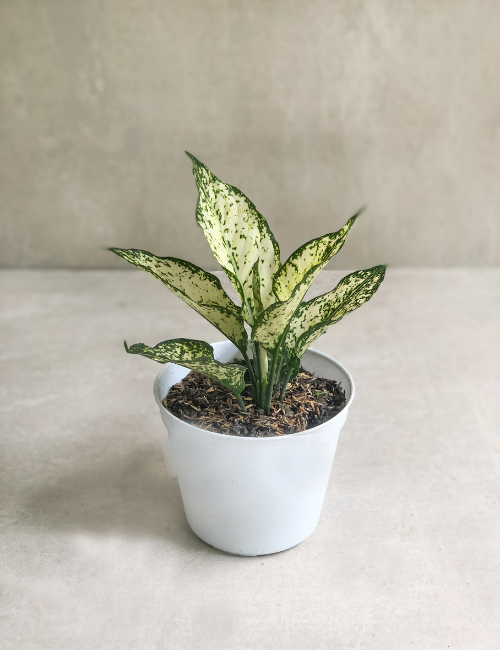 Aglaonema Snow White. Aglaonema, also known as Chinese Evergreen, is a highly decorative plant with several interesting varieties. It is one of the most popular houseplants and the colour variations—from dark green to silver, and some with hints of red—add to your home's decor. The darker green varieties of aglaonema can grow in near shade, while the variegated varieties require brighter light. Do not expose any variety of aglaonema to direct sun. 2-3 times a week, do not let the plant dry out completely.
Aglaonema Snow White. Aglaonema, also known as Chinese Evergreen, is a highly decorative plant with several interesting varieties. It is one of the most popular houseplants and the colour variations—from dark green to silver, and some with hints of red—add to your home's decor. The darker green varieties of aglaonema can grow in near shade, while the variegated varieties require brighter light. Do not expose any variety of aglaonema to direct sun. 2-3 times a week, do not let the plant dry out completely. -
 An Alocasia plant, native to Asia, is also called an Elephant Ear plant or African Mask plant because of their very large, glossy, heart-shaped leaves with wavy edges. These stunning, veined leaves come in red, bronze, blue-green, and purple. Proce include Alani Terracota M size Amazonica need bright indirect light to do their best. A little bit of morning sun or filtered sunlight is great, but keep this plant away from harsh, direct sunligh Allow the top 3-4 cm of soil to dry out before watering. Try to keep the soil evenly moist. Over-watering, wet leaves, and soggy soil makes an alocasia plant susceptible to a variety of serious fungal infections. Check the soil frequently until you are sure of the plant's watering needs
An Alocasia plant, native to Asia, is also called an Elephant Ear plant or African Mask plant because of their very large, glossy, heart-shaped leaves with wavy edges. These stunning, veined leaves come in red, bronze, blue-green, and purple. Proce include Alani Terracota M size Amazonica need bright indirect light to do their best. A little bit of morning sun or filtered sunlight is great, but keep this plant away from harsh, direct sunligh Allow the top 3-4 cm of soil to dry out before watering. Try to keep the soil evenly moist. Over-watering, wet leaves, and soggy soil makes an alocasia plant susceptible to a variety of serious fungal infections. Check the soil frequently until you are sure of the plant's watering needs -
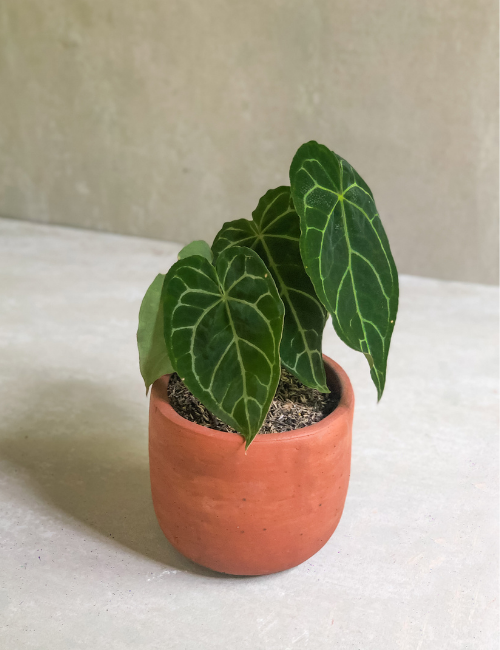 Anthurium Crystallinum in Terracota Pot. Native to Central and South America, the Anthurium Crystallinum is a heart-shaped evergreen with velvety foliage. The leaves of this beauty are dark green or reddish purple with deep, white veins that make it visually stand out. Anthuriums are widely enjoyed as outdoor plants in tropical gardens, but they also make excellent houseplants in the kitchen, patio, or living room. Full sun, partial shade 2-3 times a week
Anthurium Crystallinum in Terracota Pot. Native to Central and South America, the Anthurium Crystallinum is a heart-shaped evergreen with velvety foliage. The leaves of this beauty are dark green or reddish purple with deep, white veins that make it visually stand out. Anthuriums are widely enjoyed as outdoor plants in tropical gardens, but they also make excellent houseplants in the kitchen, patio, or living room. Full sun, partial shade 2-3 times a week -
 The Anthurium Jenmanii 'Lovely Green' is a strong, extremely strong foliage plant, ideal for offices. A fantastically beautiful plant that can simply stand in a shady place. Bright indirect light - shade tolerant 2 -3 times a week. Likes a warm humid spot, the roots should be left hanging exposed to the air and left on top of the mount. Aroids like well draining soil
The Anthurium Jenmanii 'Lovely Green' is a strong, extremely strong foliage plant, ideal for offices. A fantastically beautiful plant that can simply stand in a shady place. Bright indirect light - shade tolerant 2 -3 times a week. Likes a warm humid spot, the roots should be left hanging exposed to the air and left on top of the mount. Aroids like well draining soil -
 Anthurium Laceleaf. The red oval spathes of a flamingo flower & Laceleaf make it really distinguishable. The flowers grow on orange spadix and grow densely. The heart-shaped flowers are actually morphed leaves and called spathes. The lifeline of spathes is about 8 weeks. The flowers are small in size and perfect in shape, hence, are deemed to be true flowers. The leaves of this flower can grow up to 18 cm long and twirl around the main stem. Indirect bright light is best for your plants. If you want your Anthurium plant to thrive and bloom properly, that’s the way to go about. In the absence of proper light, the plant can become spindly as it tries to reach out for light. Please note that anthurium requires indirect light and if you place it in direct sunlight, the leaves can develop brown edges due to sunburn. Let the topmost layer dry up to two inches before you water it again. Overwatering can cause root rot while not watering the plant properly can cause brown tips on leaves. However, the pot should be well-drained and there should be an arrangement to drain excess water.
Anthurium Laceleaf. The red oval spathes of a flamingo flower & Laceleaf make it really distinguishable. The flowers grow on orange spadix and grow densely. The heart-shaped flowers are actually morphed leaves and called spathes. The lifeline of spathes is about 8 weeks. The flowers are small in size and perfect in shape, hence, are deemed to be true flowers. The leaves of this flower can grow up to 18 cm long and twirl around the main stem. Indirect bright light is best for your plants. If you want your Anthurium plant to thrive and bloom properly, that’s the way to go about. In the absence of proper light, the plant can become spindly as it tries to reach out for light. Please note that anthurium requires indirect light and if you place it in direct sunlight, the leaves can develop brown edges due to sunburn. Let the topmost layer dry up to two inches before you water it again. Overwatering can cause root rot while not watering the plant properly can cause brown tips on leaves. However, the pot should be well-drained and there should be an arrangement to drain excess water. -
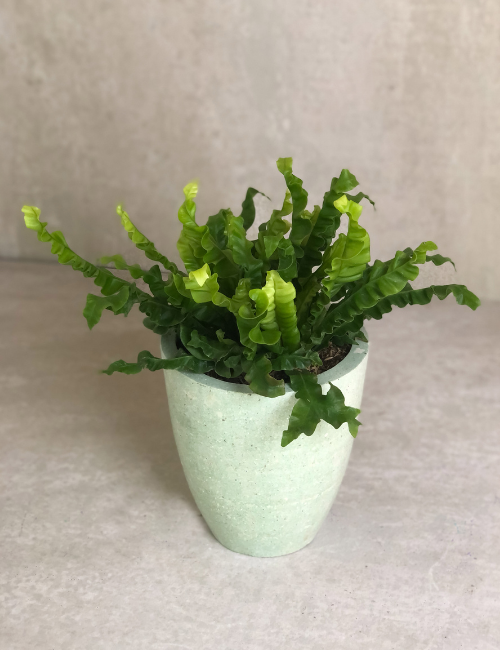 Asplenium Lasagna in Emerald Terrazzo. Known as Kadaka Lasagna in Indonesia this plant is a favourite because its very wiggle-edged lush fern for tropical gardens and indoor decor - plant it somewhere shady and moist and watch it unfurl. No direct sunlight Only after Soil dries completely
Asplenium Lasagna in Emerald Terrazzo. Known as Kadaka Lasagna in Indonesia this plant is a favourite because its very wiggle-edged lush fern for tropical gardens and indoor decor - plant it somewhere shady and moist and watch it unfurl. No direct sunlight Only after Soil dries completely -
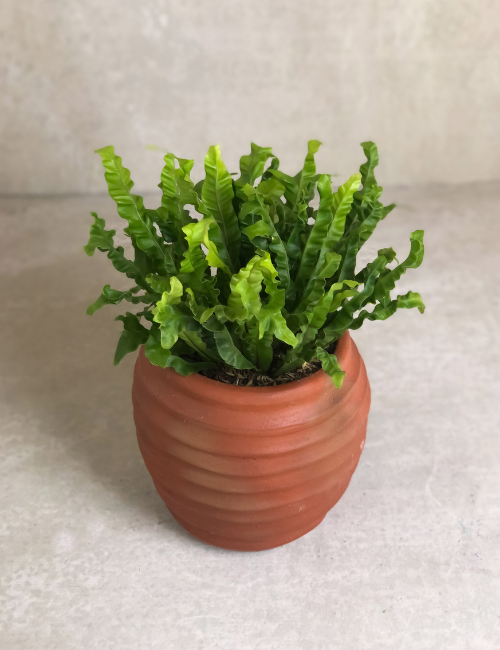 Asplenium Lasagna in Honey Bee Terracotta. Known as Kadaka Lasagna in Indonesia this plant is a favourite because its very wiggle-edged lush fern for tropical gardens and indoor decor - plant it somewhere shady and moist and watch it unfurl. No direct sunlight Only after Soil dries completely
Asplenium Lasagna in Honey Bee Terracotta. Known as Kadaka Lasagna in Indonesia this plant is a favourite because its very wiggle-edged lush fern for tropical gardens and indoor decor - plant it somewhere shady and moist and watch it unfurl. No direct sunlight Only after Soil dries completely -
 Asplenium Lasagna in White Terrazzo. Known as Kadaka Lasagna in Indonesia this plant is a favourite because its very wiggle-edged lush fern for tropical gardens and indoor decor - plant it somewhere shady and moist and watch it unfurl. No direct sunlight Only after Soil dries completely
Asplenium Lasagna in White Terrazzo. Known as Kadaka Lasagna in Indonesia this plant is a favourite because its very wiggle-edged lush fern for tropical gardens and indoor decor - plant it somewhere shady and moist and watch it unfurl. No direct sunlight Only after Soil dries completely -
 Begonia Malculata. Begonia maculata, or Polka Dot begonia as it’s often called, is a splashy show-stopper that looks fantastic with it’s olive green leaves and contrasting spots. It’s a houseplant that is likely to turn heads in your home, and thankfully it isn’t too difficult to care for. Bright, indirect light. Higher light levels will promote strong growth and blooms, but avoid direct sunlight Keep the soil generally moist, letting the top half inch of soil dry out between watering. Will not tolerate soggy soil.
Begonia Malculata. Begonia maculata, or Polka Dot begonia as it’s often called, is a splashy show-stopper that looks fantastic with it’s olive green leaves and contrasting spots. It’s a houseplant that is likely to turn heads in your home, and thankfully it isn’t too difficult to care for. Bright, indirect light. Higher light levels will promote strong growth and blooms, but avoid direct sunlight Keep the soil generally moist, letting the top half inch of soil dry out between watering. Will not tolerate soggy soil. -
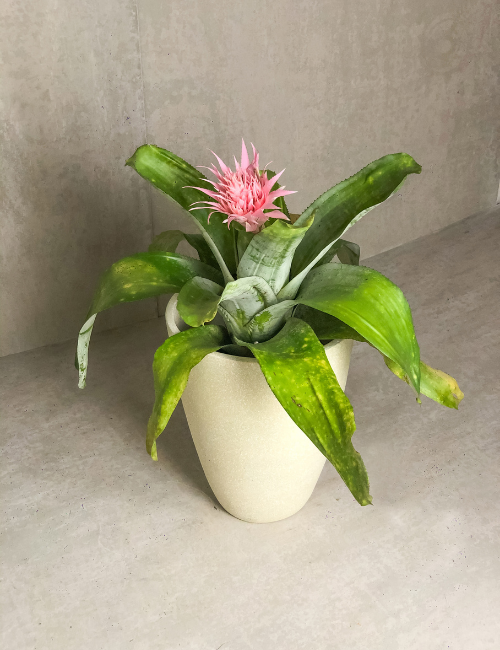 Bromeliad Aechmea in Alani Terakota. Bromeliad Aechmea is a tropical epiphyte, meaning that they naturally grow in trees for support. They are not parasitic, and have roots that cling to branches. The flowers are actually bracts that can remain colourful for up to 2 or more months. Aechmeas like bright light, like near an east or west window. They need this exposure to bring out the variegation in their foliage & also to flower. 2-3 times a week. If the soil is nearly dry, water it don't let the soil dry out entirely.
Bromeliad Aechmea in Alani Terakota. Bromeliad Aechmea is a tropical epiphyte, meaning that they naturally grow in trees for support. They are not parasitic, and have roots that cling to branches. The flowers are actually bracts that can remain colourful for up to 2 or more months. Aechmeas like bright light, like near an east or west window. They need this exposure to bring out the variegation in their foliage & also to flower. 2-3 times a week. If the soil is nearly dry, water it don't let the soil dry out entirely. -
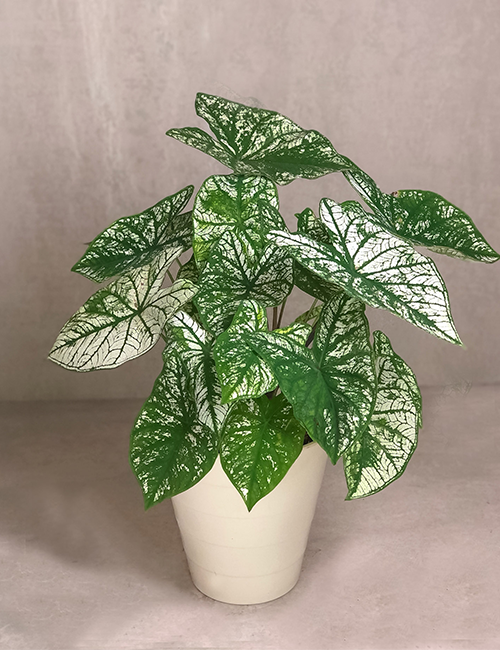 An outstanding variety producing luminous white leaves with contrasting dark green veins and lighter green edges; this one really stands out in a shaded area, and lends to show off other plants; a great container plant, indoors or out. The caladium prefers indirect light or moderate shade indoors. The narrower the leaves, the greater the sun it can withstand. When leaves appear on the plant, water as needed to keep the soil evenly moist. Never let the plant dry out.
An outstanding variety producing luminous white leaves with contrasting dark green veins and lighter green edges; this one really stands out in a shaded area, and lends to show off other plants; a great container plant, indoors or out. The caladium prefers indirect light or moderate shade indoors. The narrower the leaves, the greater the sun it can withstand. When leaves appear on the plant, water as needed to keep the soil evenly moist. Never let the plant dry out. -
 Calathea Ctenanthe Burle Marxii Amabilis The Peacock plant has large light glossy green leaves with dark green veins and blotchy patterns. The attractive foliage has a pattern reminiscent of a peacock’s tail feathers. New leaves grow rolled up exposing the purple colour underside. Calathea plants need bright, but not direct, sunlight to grow. This is because they grow on the floor of jungles and forests where they get limited light through the tops of the trees. In fact, direct sunlight will burn the leaves of a Calathea plant and cause it to lose its vibrant colors. 2-3 times a week, Calathea like to have moist soil or planting substances, but not soggy. They do not want lots of water.
Calathea Ctenanthe Burle Marxii Amabilis The Peacock plant has large light glossy green leaves with dark green veins and blotchy patterns. The attractive foliage has a pattern reminiscent of a peacock’s tail feathers. New leaves grow rolled up exposing the purple colour underside. Calathea plants need bright, but not direct, sunlight to grow. This is because they grow on the floor of jungles and forests where they get limited light through the tops of the trees. In fact, direct sunlight will burn the leaves of a Calathea plant and cause it to lose its vibrant colors. 2-3 times a week, Calathea like to have moist soil or planting substances, but not soggy. They do not want lots of water. -
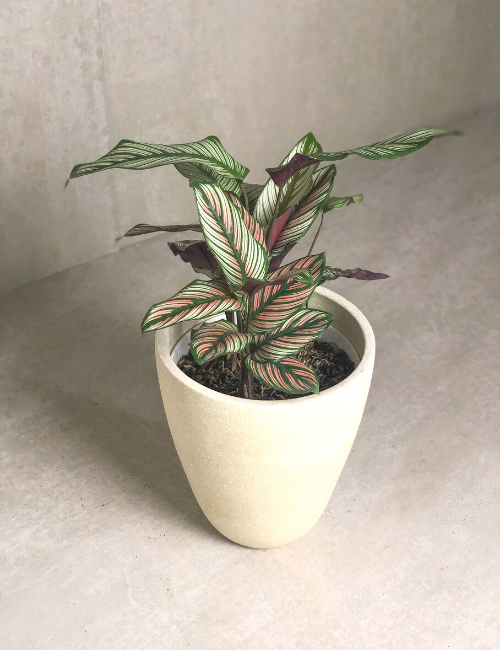 Calathea Majestica ‘White Star’ in Alani Terracotta. Calathea Majestica ‘White Star’ is a cultivar of the Ornata Species and one of the most elegant. With paint like white and pink stripes on the leaves, this calathea is a staple plant for the passionate collector. Bright, indirect light 2 to 3 times a week. If the soil is nearly dry, water it don't let the soil dry out entirely
Calathea Majestica ‘White Star’ in Alani Terracotta. Calathea Majestica ‘White Star’ is a cultivar of the Ornata Species and one of the most elegant. With paint like white and pink stripes on the leaves, this calathea is a staple plant for the passionate collector. Bright, indirect light 2 to 3 times a week. If the soil is nearly dry, water it don't let the soil dry out entirely -
 Calathea Majestica ‘White Star’ is a cultivar of the Ornata Species and one of the most elegant. With paint like white and pink stripes on the leaves, this calathea is a staple plant for the passionate collector. Added bonus: Calathea are not poisonous which means it’s pet friendly (non toxic to cats and dogs). Calathea love bright, indirect light Allow the soil to dry out halfway before watering. Typically when you see the surface of the soil is dry, it's safe to give them a water.
Calathea Majestica ‘White Star’ is a cultivar of the Ornata Species and one of the most elegant. With paint like white and pink stripes on the leaves, this calathea is a staple plant for the passionate collector. Added bonus: Calathea are not poisonous which means it’s pet friendly (non toxic to cats and dogs). Calathea love bright, indirect light Allow the soil to dry out halfway before watering. Typically when you see the surface of the soil is dry, it's safe to give them a water. -
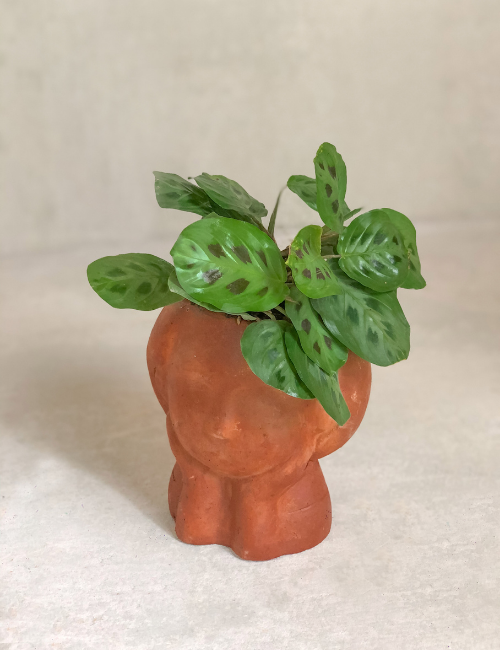 Calathea Maranta Leuconeura in Wonder Terracotta Calathea Maranta Leuconeura ‘Kim’ is a purple-spotted variety of prayer plant. Aside from the purple spots, the leaves have a cream-white streak for extra flair. Native to the tropical forests of Brazil, prayer plants are some of the most beautiful indoor houseplants you can find. They’re great in hanging baskets as they spread low and wide You can hang or set your prayer plant near a window where it will receive indirect sunlight. Never set your plant in direct sunlight because the sun will scorch the plant’s leaves or the leaves will develop blotches or patches and fade in color intensity. 2-3 times a week. Water the prayer plant when the top of the potting soil is just starting to become dry. These plants are very susceptible to drought; however, to avoid fungal problems, do not let water sit directly on the leaves or let the plant get soggy.
Calathea Maranta Leuconeura in Wonder Terracotta Calathea Maranta Leuconeura ‘Kim’ is a purple-spotted variety of prayer plant. Aside from the purple spots, the leaves have a cream-white streak for extra flair. Native to the tropical forests of Brazil, prayer plants are some of the most beautiful indoor houseplants you can find. They’re great in hanging baskets as they spread low and wide You can hang or set your prayer plant near a window where it will receive indirect sunlight. Never set your plant in direct sunlight because the sun will scorch the plant’s leaves or the leaves will develop blotches or patches and fade in color intensity. 2-3 times a week. Water the prayer plant when the top of the potting soil is just starting to become dry. These plants are very susceptible to drought; however, to avoid fungal problems, do not let water sit directly on the leaves or let the plant get soggy. -
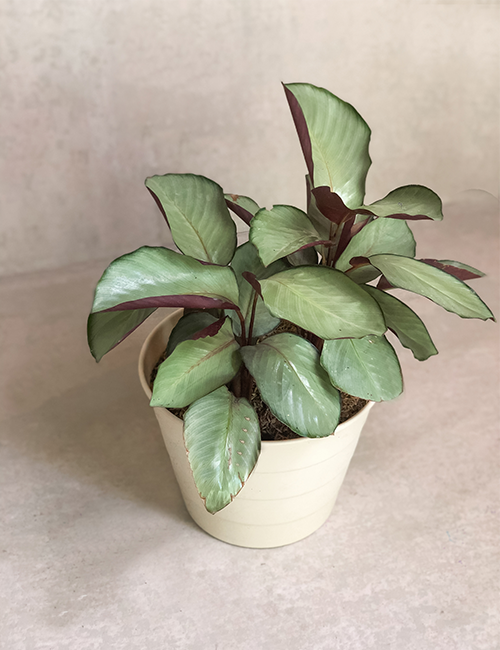 Calathea ‘Silver Plate’ has beautiful leaves which are uniformly glossy greenish-grey on top, purple below, sometimes with green margin, broadly ovate. Leaf stalks are purple that makes a wonderful indoor plant with decent look in your calathea collection. Bright but indirect light. Only water after Soil dries completely
Calathea ‘Silver Plate’ has beautiful leaves which are uniformly glossy greenish-grey on top, purple below, sometimes with green margin, broadly ovate. Leaf stalks are purple that makes a wonderful indoor plant with decent look in your calathea collection. Bright but indirect light. Only water after Soil dries completely -
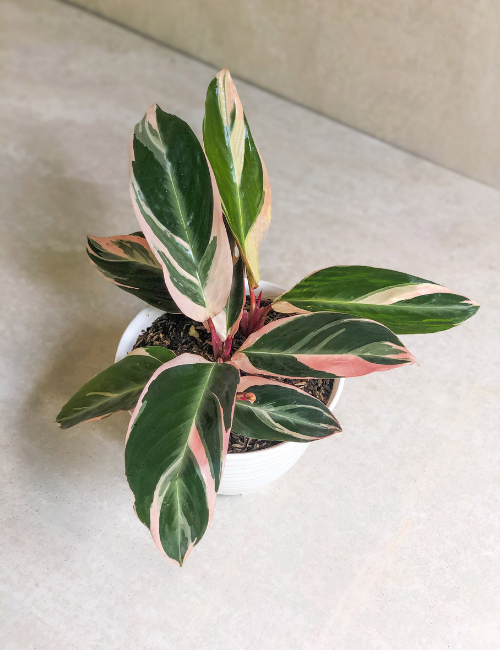 Calathea Stromanthe Triostar. The Stromanthe Triostar is one of those sensational, star-quality plants you fall in love with immediately. Its artistically splashed green-and-white foliage glows with pinkish hues will add extra colours to your home. Prefers bright indirect light, avoid harsh direct sunlight that may burn your plant’s leaves. Water about once a week (or more often if environment is very warm) to keep soil evenly moist but never soggy. Mist between watering to provide humidity.
Calathea Stromanthe Triostar. The Stromanthe Triostar is one of those sensational, star-quality plants you fall in love with immediately. Its artistically splashed green-and-white foliage glows with pinkish hues will add extra colours to your home. Prefers bright indirect light, avoid harsh direct sunlight that may burn your plant’s leaves. Water about once a week (or more often if environment is very warm) to keep soil evenly moist but never soggy. Mist between watering to provide humidity. -
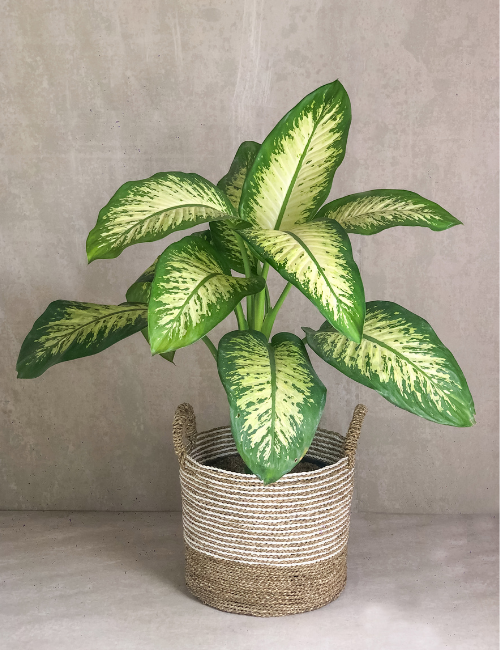 Dieffenbachia Seguine 'Tropic Snow'. Everything about the dumb cane, or dieffenbachia, is dramatic. Native to the tropics of Central and South America, it has huge variegated leaves. Even the way it grows is showy, new leaves curling up from the central stem before they unfurl. Price exclude basket. Diffenbachia likes a good amount of light throughout the day, but ideally not direct sunlight. 2-3 times a week. Water sparingly, making the potting mixture barely moist and allowing the top third to dry out before watering again.
Dieffenbachia Seguine 'Tropic Snow'. Everything about the dumb cane, or dieffenbachia, is dramatic. Native to the tropics of Central and South America, it has huge variegated leaves. Even the way it grows is showy, new leaves curling up from the central stem before they unfurl. Price exclude basket. Diffenbachia likes a good amount of light throughout the day, but ideally not direct sunlight. 2-3 times a week. Water sparingly, making the potting mixture barely moist and allowing the top third to dry out before watering again. -
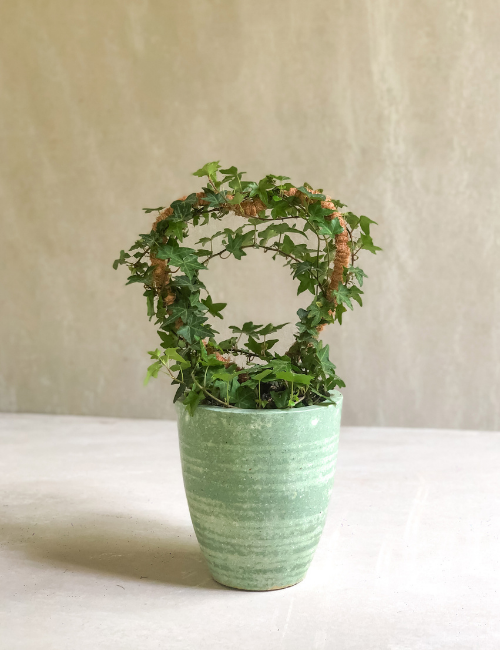 English Ivy in Emerald Terrazzo Pot. English ivy is also a very popular indoor houseplant or for use in outdoor hanging baskets. Ivy can make a wonderful, bright light houseplant. It can grow long and lush and bring a bit of the outdoors inside. Price include Emerald Terrazzo Pot. Filtered sun or partial shade 2 -3 times a week. Potted ivy prefers moist, humid conditions, but not soaking. Don’t let the soil dry out and keep it evenly moist
English Ivy in Emerald Terrazzo Pot. English ivy is also a very popular indoor houseplant or for use in outdoor hanging baskets. Ivy can make a wonderful, bright light houseplant. It can grow long and lush and bring a bit of the outdoors inside. Price include Emerald Terrazzo Pot. Filtered sun or partial shade 2 -3 times a week. Potted ivy prefers moist, humid conditions, but not soaking. Don’t let the soil dry out and keep it evenly moist -
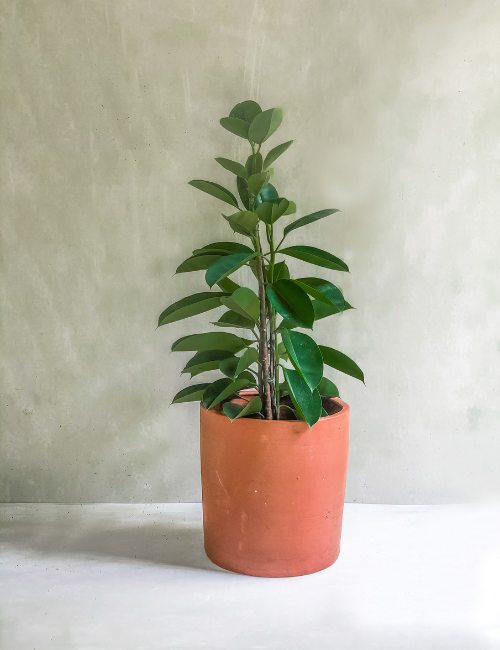 Ficus Elastica in Terracotta. If you’re looking for a houseplant that makes a bold statement, then look no further than a Rubber Plant (Ficus elastica), also called Indian Rubber Tree. With their ease of care, these are perfect indoor plants for beginners or those who consider themselves having a black thumb. Price include Terracotta Pot. A nice brightly lit spot is ideal, without direct sunlight. Water once the soil becomes slightly dry to the touch and make sure the pot has sufficient drainage holes to allow excess water to seep through. The worst thing you can do regarding watering is "give it too much".
Ficus Elastica in Terracotta. If you’re looking for a houseplant that makes a bold statement, then look no further than a Rubber Plant (Ficus elastica), also called Indian Rubber Tree. With their ease of care, these are perfect indoor plants for beginners or those who consider themselves having a black thumb. Price include Terracotta Pot. A nice brightly lit spot is ideal, without direct sunlight. Water once the soil becomes slightly dry to the touch and make sure the pot has sufficient drainage holes to allow excess water to seep through. The worst thing you can do regarding watering is "give it too much". -
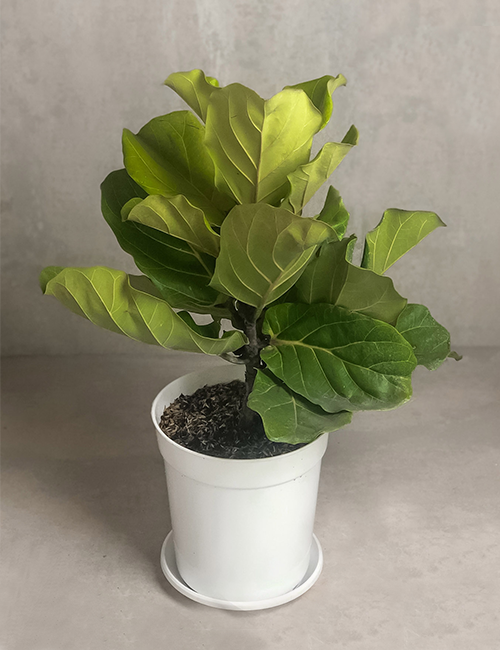 Native to the rainforests of western and central Africa, the Fiddle Leaf Fig Tree (Ficus lyrata) is a stunning plant with huge green leaves and an even larger following of houseplant fans. Fiddle leaf figs prefer lots of bright, filtered light. Keep your fiddle leaf fig near a sunny, east-facing window so it can take in lots of sunshine throughout the day. 2 -3 times a week. Wait for the top inch of your fiddle leaf fig tree’s soil to dry before you pick up your watering can.
Native to the rainforests of western and central Africa, the Fiddle Leaf Fig Tree (Ficus lyrata) is a stunning plant with huge green leaves and an even larger following of houseplant fans. Fiddle leaf figs prefer lots of bright, filtered light. Keep your fiddle leaf fig near a sunny, east-facing window so it can take in lots of sunshine throughout the day. 2 -3 times a week. Wait for the top inch of your fiddle leaf fig tree’s soil to dry before you pick up your watering can. -
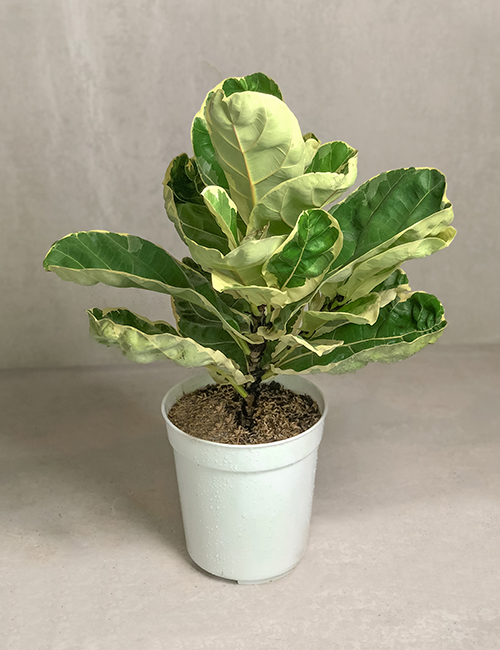 Native to the rainforests of western and central Africa, the Fiddle Leaf Fig Tree (Ficus lyrata) is a stunning plant with huge green leaves and an even larger following of houseplant fans. Fiddle leaf figs prefer lots of bright, filtered light. Keep your fiddle leaf fig near a sunny, east-facing window so it can take in lots of sunshine throughout the day. 2 -3 times a week. Wait for the top inch of your fiddle leaf fig tree’s soil to dry before you pick up your watering can.
Native to the rainforests of western and central Africa, the Fiddle Leaf Fig Tree (Ficus lyrata) is a stunning plant with huge green leaves and an even larger following of houseplant fans. Fiddle leaf figs prefer lots of bright, filtered light. Keep your fiddle leaf fig near a sunny, east-facing window so it can take in lots of sunshine throughout the day. 2 -3 times a week. Wait for the top inch of your fiddle leaf fig tree’s soil to dry before you pick up your watering can. -
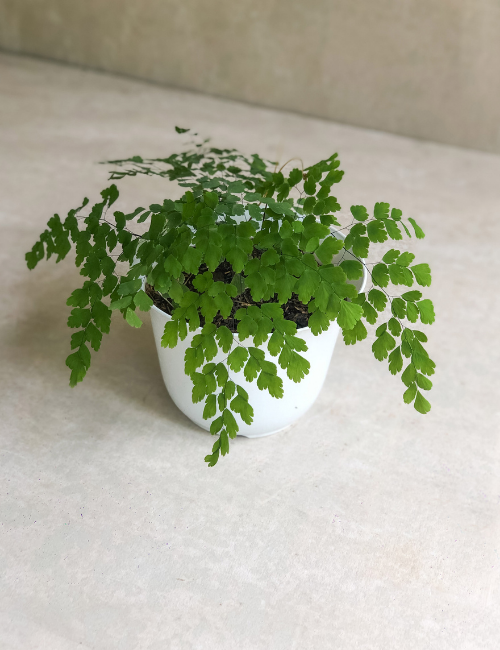 Maidenhair Fern. Maidenhair ferns have delicate fan-shaped leaf segments, typically clustered on wiry black stems. In addition to being a popular houseplant, maidenhair fern can also be found in nature, growing in places where other plants typically don't, like on rock walls and in between rock fissures where the moisture from water seepage keeps them alive. Prefers bright indirect light, avoid harsh direct sunlight that may burn your plant’s leaves. 2-3 times a week. Water sparingly, making the potting mixture barely moist and allowing the top third to dry out before watering again.
Maidenhair Fern. Maidenhair ferns have delicate fan-shaped leaf segments, typically clustered on wiry black stems. In addition to being a popular houseplant, maidenhair fern can also be found in nature, growing in places where other plants typically don't, like on rock walls and in between rock fissures where the moisture from water seepage keeps them alive. Prefers bright indirect light, avoid harsh direct sunlight that may burn your plant’s leaves. 2-3 times a week. Water sparingly, making the potting mixture barely moist and allowing the top third to dry out before watering again. -
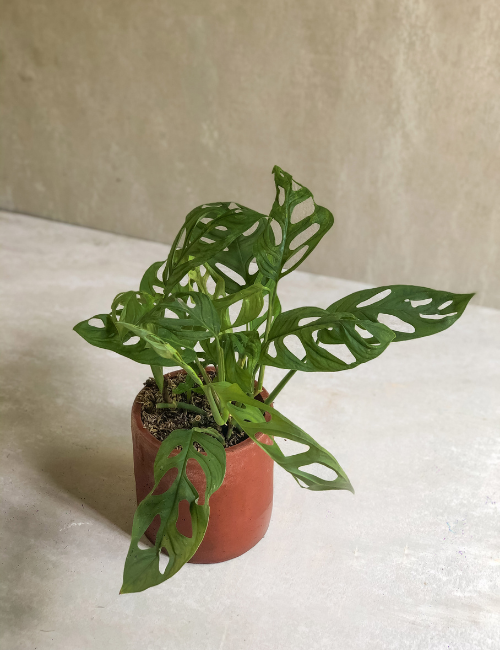 Monstera Adansonii in Terracotta. The Swiss cheese plant, Monstera Adansonii, gets its name from its large, heart-shaped leaves, and as the plant ages, the leaves develop holes (called fenestration) that makes the leaves resemble Swiss cheese. Swiss cheese plant is a tropical perennial plant native to Central and South American that is typically grown as a houseplant. Swiss cheese plant is very easy to grow. The plants grow best in indirect sunlight. If direct sunlight is unavoidable, limit the exposure to just two to three hours of morning sun. 2-3 times a week. If the soil is nearly dry, water it don't let the soil dry out entirely.
Monstera Adansonii in Terracotta. The Swiss cheese plant, Monstera Adansonii, gets its name from its large, heart-shaped leaves, and as the plant ages, the leaves develop holes (called fenestration) that makes the leaves resemble Swiss cheese. Swiss cheese plant is a tropical perennial plant native to Central and South American that is typically grown as a houseplant. Swiss cheese plant is very easy to grow. The plants grow best in indirect sunlight. If direct sunlight is unavoidable, limit the exposure to just two to three hours of morning sun. 2-3 times a week. If the soil is nearly dry, water it don't let the soil dry out entirely. -
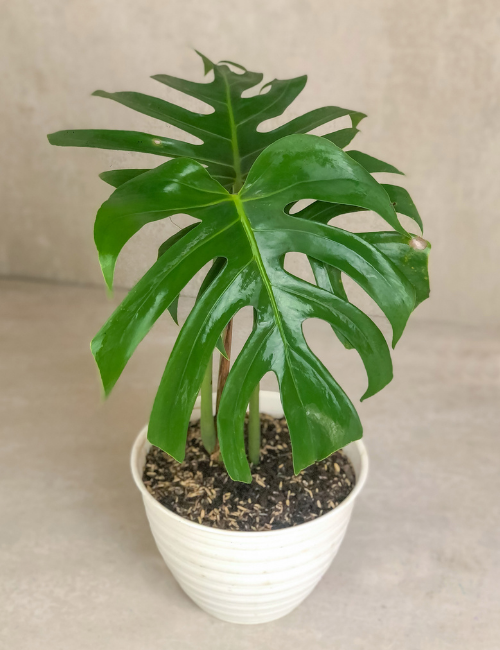 Monstera Borsigiana. Monstera Borsigiana, otherwise known as the Swiss cheese plant, grows wildly in the jungles of southern Mexico and Panama. These leafy guys look great in any home and make a statement in almost any corner of a room. The right amount of sunlight is essential for a monstera’s leaf development. Place it in a spot where it can receive filtered, indirect sunlight. 2-3 times a week. Water sparingly, making the potting mixture barely moist and allowing the top third to dry out before watering again.
Monstera Borsigiana. Monstera Borsigiana, otherwise known as the Swiss cheese plant, grows wildly in the jungles of southern Mexico and Panama. These leafy guys look great in any home and make a statement in almost any corner of a room. The right amount of sunlight is essential for a monstera’s leaf development. Place it in a spot where it can receive filtered, indirect sunlight. 2-3 times a week. Water sparingly, making the potting mixture barely moist and allowing the top third to dry out before watering again. -
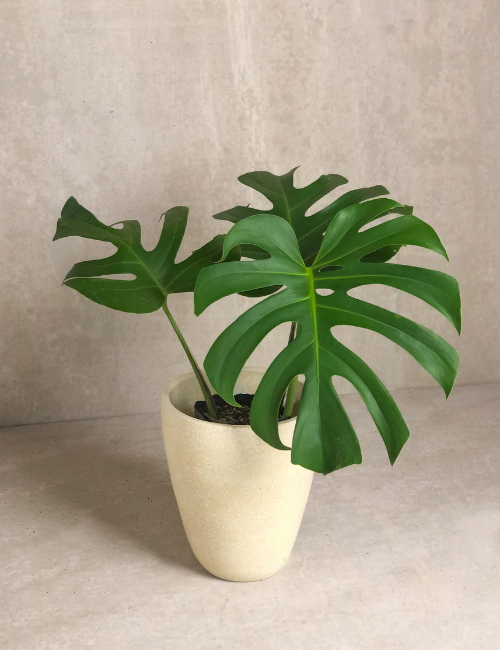 Monstera Borsigiana in Alani Terracotta. Monstera Borsigiana, otherwise known as the Swiss cheese plant, grows wildly in the jungles of southern Mexico and Panama. These leafy guys look great in any home and make a statement in almost any corner of a room. The right amount of sunlight is essential for a monstera’s leaf development. Place it in a spot where it can receive filtered, indirect sunlight. 2-3 times a week. Water sparingly, making the potting mixture barely moist and allowing the top third to dry out before watering again.
Monstera Borsigiana in Alani Terracotta. Monstera Borsigiana, otherwise known as the Swiss cheese plant, grows wildly in the jungles of southern Mexico and Panama. These leafy guys look great in any home and make a statement in almost any corner of a room. The right amount of sunlight is essential for a monstera’s leaf development. Place it in a spot where it can receive filtered, indirect sunlight. 2-3 times a week. Water sparingly, making the potting mixture barely moist and allowing the top third to dry out before watering again. -
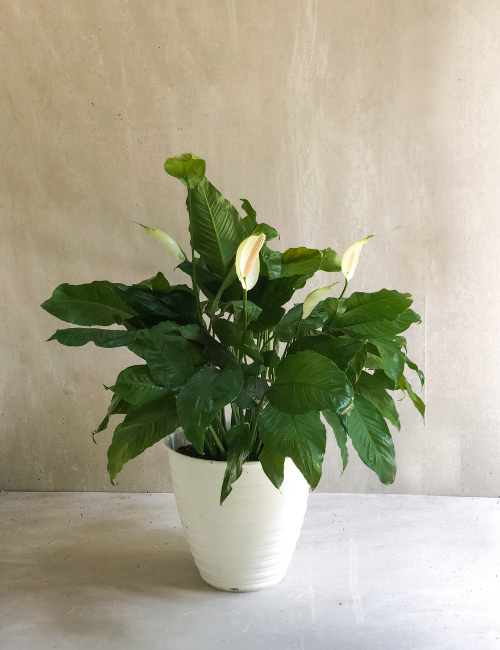 Peace Lily. Peace lilies are tropical, evergreen plants that thrive on the forest floor, where they receive dappled sunlight and consistent moisture. This tropical shade-loving plant helps cleanse the air we breathe. While we all appreciate cleaner, oxygenated air, it’s also the easy peace lily care, resiliency and forgiving nature that makes them such popular houseplants. This Peace Lily is Extra Large size with height between 80 – 100cm and pot diameter 45cm. Keep these plants out of direct afternoon sunlight, but in a bright, well-lit area. An east-facing window is ideal, as they will be exposed to the bright morning sun but avoid the intensity of mid-day rays. Peace lilies are far more tolerant of underwatering than overwatering, which is one of the most common reasons for a peace lily to die. Because of this, you should never water peace lily plants on a schedule. Rather, you should check them once a week to see if they need to be watered. Simply touch the top of the soil to see if it is dry. If it is, water your peace lily.
Peace Lily. Peace lilies are tropical, evergreen plants that thrive on the forest floor, where they receive dappled sunlight and consistent moisture. This tropical shade-loving plant helps cleanse the air we breathe. While we all appreciate cleaner, oxygenated air, it’s also the easy peace lily care, resiliency and forgiving nature that makes them such popular houseplants. This Peace Lily is Extra Large size with height between 80 – 100cm and pot diameter 45cm. Keep these plants out of direct afternoon sunlight, but in a bright, well-lit area. An east-facing window is ideal, as they will be exposed to the bright morning sun but avoid the intensity of mid-day rays. Peace lilies are far more tolerant of underwatering than overwatering, which is one of the most common reasons for a peace lily to die. Because of this, you should never water peace lily plants on a schedule. Rather, you should check them once a week to see if they need to be watered. Simply touch the top of the soil to see if it is dry. If it is, water your peace lily. -
 Peperomia Watermelon in Alani Terracota. Watermelon peperomia (Peperomia argyreia) is appreciated for its rounded, fleshy leaves marked with silver and dark green stripes that resemble the markings of a watermelon. Watermelon peperomia is a low-growing plant that reaches only 6 to 8 inches tall at maturity. Prce include Alani Terracotta pot, exclude wood stand. Watermelon peperomia thrives in bright, indirect sunlight. Water thoroughly when the top 2 – 3 cm of soil is dry to the touch. Allow the soil to dry out a bit between watering. Always keep an eye on your plant–if the leaves droop or feel a bit thin, it may also be time to water.
Peperomia Watermelon in Alani Terracota. Watermelon peperomia (Peperomia argyreia) is appreciated for its rounded, fleshy leaves marked with silver and dark green stripes that resemble the markings of a watermelon. Watermelon peperomia is a low-growing plant that reaches only 6 to 8 inches tall at maturity. Prce include Alani Terracotta pot, exclude wood stand. Watermelon peperomia thrives in bright, indirect sunlight. Water thoroughly when the top 2 – 3 cm of soil is dry to the touch. Allow the soil to dry out a bit between watering. Always keep an eye on your plant–if the leaves droop or feel a bit thin, it may also be time to water. -
 The plant originates from rainforests in Brazil and Argentina. In the Philodendron Bipennifolium’s natural habitat, it wraps itself around trees. The Philodendron Bipennifolium plant needs sunlight. But the plant’s leaves can’t take direct sunlight shining down on them. 2 -3 times a week. When watering your Philodendron Bipennifolium, you want the soil moist. But you don’t want the soil saturated.
The plant originates from rainforests in Brazil and Argentina. In the Philodendron Bipennifolium’s natural habitat, it wraps itself around trees. The Philodendron Bipennifolium plant needs sunlight. But the plant’s leaves can’t take direct sunlight shining down on them. 2 -3 times a week. When watering your Philodendron Bipennifolium, you want the soil moist. But you don’t want the soil saturated. -
 Philodendron Green. Philodendron houseplants thrive indoors year round without complaint, but they enjoy an occasional stay outdoors in a shady spot when the weather permits. Taking the plant outdoors also gives you a chance to flush the soil with plenty of fresh water and clean the leaves. Unlike most houseplants, philodendrons don’t experience as much stress when moving from indoor to outdoor settings. Price include Alani Terracotta. Set the plant in a location with bright, indirect sunlight. Find a position near a window where the sun’s rays never actually touch the foliage. Bit between watering. Always keep an eye on your plant–if the leaves droop or feel a bit thin, it may also be time to water.
Philodendron Green. Philodendron houseplants thrive indoors year round without complaint, but they enjoy an occasional stay outdoors in a shady spot when the weather permits. Taking the plant outdoors also gives you a chance to flush the soil with plenty of fresh water and clean the leaves. Unlike most houseplants, philodendrons don’t experience as much stress when moving from indoor to outdoor settings. Price include Alani Terracotta. Set the plant in a location with bright, indirect sunlight. Find a position near a window where the sun’s rays never actually touch the foliage. Bit between watering. Always keep an eye on your plant–if the leaves droop or feel a bit thin, it may also be time to water. -
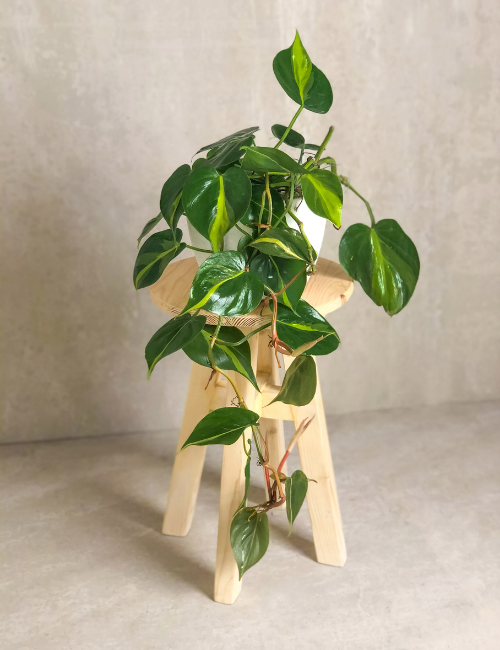 Philodendron Hederaceum 'Brasil'. Philodendron hederaceum 'Brasil' is a wild and bold cultivar of the classic Heartleaf Philodendron. Its variegated leaves look almost painted, with strokes of yellow and lime green across the deep green foliage. Low to bright, indirect light. 2-3 times a week. Water sparingly, making the potting mixture barely moist and allowing the top third to dry out before watering again.
Philodendron Hederaceum 'Brasil'. Philodendron hederaceum 'Brasil' is a wild and bold cultivar of the classic Heartleaf Philodendron. Its variegated leaves look almost painted, with strokes of yellow and lime green across the deep green foliage. Low to bright, indirect light. 2-3 times a week. Water sparingly, making the potting mixture barely moist and allowing the top third to dry out before watering again. -
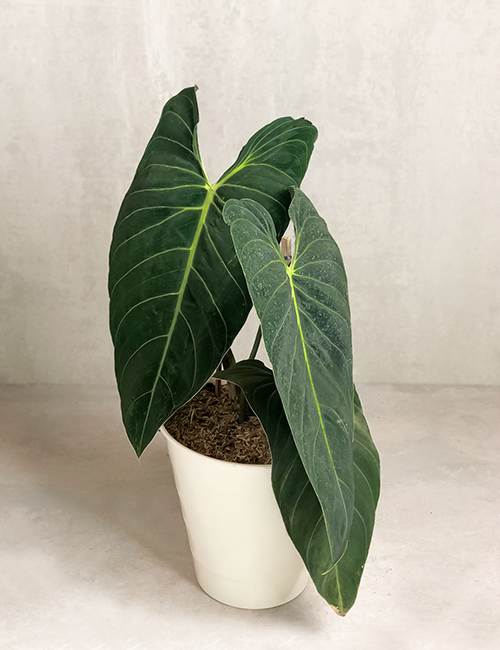 Melanochrysum is a large velvet leaf variety of philodendron whose leaves start out pink with light green veins and slowly matures into a deep dark green with a velvety texture. This plant does require a totem or some sort of pole to climb otherwise it will tendency to meander and droop. This is a superior variety philodendron which is quite easy to grow. Philodendron Melanochrysum enjoys bright shade. Bright shade stands for filtered sunlight or indirect bright light. Make sure that the soil never dries out. You will need to hydrate your plant all the time, but also avoid over-watering.
Melanochrysum is a large velvet leaf variety of philodendron whose leaves start out pink with light green veins and slowly matures into a deep dark green with a velvety texture. This plant does require a totem or some sort of pole to climb otherwise it will tendency to meander and droop. This is a superior variety philodendron which is quite easy to grow. Philodendron Melanochrysum enjoys bright shade. Bright shade stands for filtered sunlight or indirect bright light. Make sure that the soil never dries out. You will need to hydrate your plant all the time, but also avoid over-watering. -
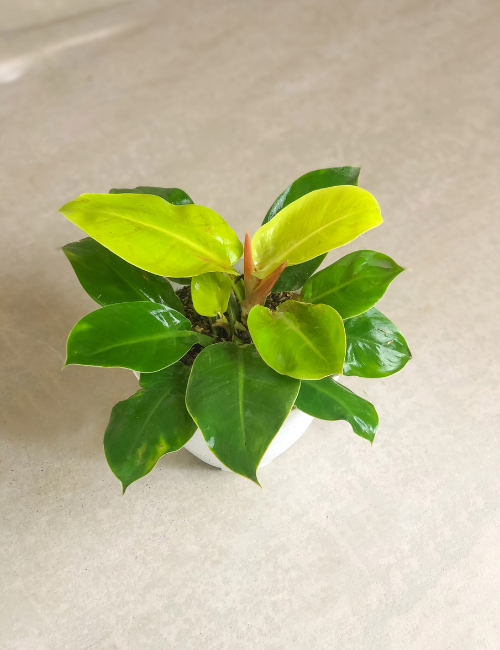 Philodendron Moonlight. This evergreen, clumping cultivar goes by the common name lime Philodendron. Why? Its leaves, and new growth sport a bright yellow-green chartreuse color. This color barely fades over time. Bright partial shade or indirect light will ensure a happy moonlight Philodendron. 2 to 3 times a week. If the soil is nearly dry, water it don't let the soil dry out entirely.
Philodendron Moonlight. This evergreen, clumping cultivar goes by the common name lime Philodendron. Why? Its leaves, and new growth sport a bright yellow-green chartreuse color. This color barely fades over time. Bright partial shade or indirect light will ensure a happy moonlight Philodendron. 2 to 3 times a week. If the soil is nearly dry, water it don't let the soil dry out entirely. -
 Pilea Depressa in Pedro Terracotta. Pilea Depressa is an evergreen ornamental climber native to Brazil and Mexico. The tiny green leaves with scalloped edges are less than ¼ of an inch and grow on delicate pinkish stems. Numerous tiny, white, petal-less flowers grow in the spring to make it nothing less than a fairy vine. Price include Pedro Terracotta. The plant usually requires bright shade. In outdoors, select a well-lit shady area. Importantly, keep it away from direct sun, especially the peak hours. 2-3 times a week, make sure the top or 2-3 cm of the soil should be kept moist
Pilea Depressa in Pedro Terracotta. Pilea Depressa is an evergreen ornamental climber native to Brazil and Mexico. The tiny green leaves with scalloped edges are less than ¼ of an inch and grow on delicate pinkish stems. Numerous tiny, white, petal-less flowers grow in the spring to make it nothing less than a fairy vine. Price include Pedro Terracotta. The plant usually requires bright shade. In outdoors, select a well-lit shady area. Importantly, keep it away from direct sun, especially the peak hours. 2-3 times a week, make sure the top or 2-3 cm of the soil should be kept moist -
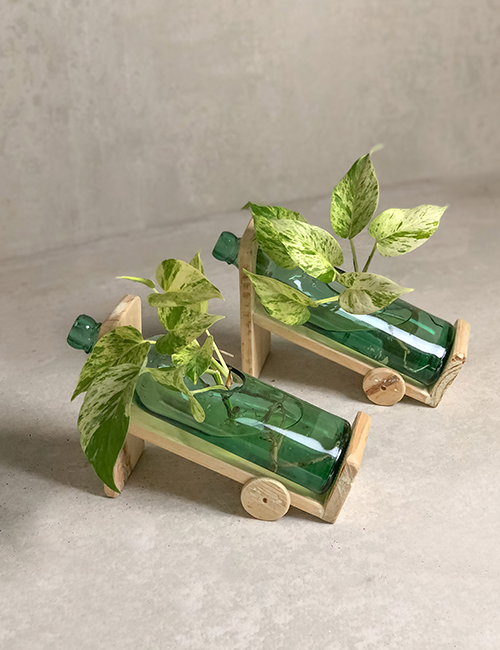 The pothos plant is considered by many to be a great way to get started caring for houseplants. Because pothos care in easy and undemanding, this lovely plant is an easy way to add some green in your home. To add up chic and unique essential to your home this Pothos in Recycle Bottle Frame will suit any corner and easy to care to just add water every 3- 4 days. Indoors, pothos prefers bright but indirect light. 3- 4 times a week, expect to water more often in brighter light and less often in lower light.
The pothos plant is considered by many to be a great way to get started caring for houseplants. Because pothos care in easy and undemanding, this lovely plant is an easy way to add some green in your home. To add up chic and unique essential to your home this Pothos in Recycle Bottle Frame will suit any corner and easy to care to just add water every 3- 4 days. Indoors, pothos prefers bright but indirect light. 3- 4 times a week, expect to water more often in brighter light and less often in lower light. -
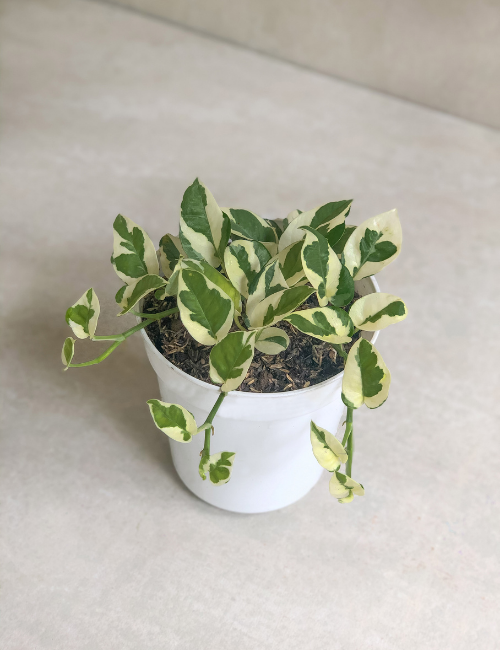 Pothos N'Joy. The tender leaves are fresh and are appealing, this plant unlike other pothos is not a fast grower, the color combination of so magnificent that you cannot move your eyes away from the plant. They love bright indirect light and no harm if exposed to morning sun but make sure that the plant is not exposed to harsh sun light as this may burn the leaves. 2-3 times a week. The Pothos N-joy grows best in moist soil be careful not to overwater it.
Pothos N'Joy. The tender leaves are fresh and are appealing, this plant unlike other pothos is not a fast grower, the color combination of so magnificent that you cannot move your eyes away from the plant. They love bright indirect light and no harm if exposed to morning sun but make sure that the plant is not exposed to harsh sun light as this may burn the leaves. 2-3 times a week. The Pothos N-joy grows best in moist soil be careful not to overwater it. -
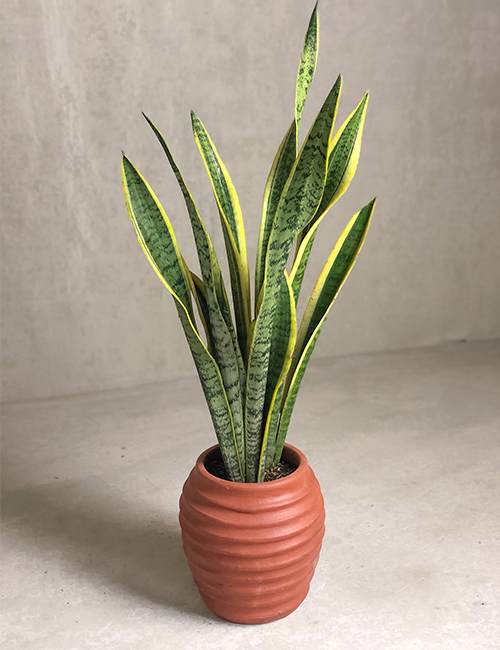 Sansevierias (Snake Plants) are some of the toughest plants you can find. Whether indoors, in your garden or on your balcony, these spiky beauties can put up with almost anything. Sansiviera prefer bright, indirect light and can even tolerate some direct sunlight. However, they also grow well (albeit more slowly) in shady corners and other low-light areas of the home. 3 -5 times a week depends on humidity of your room, please make sure to touch the soil before you water it.
Sansevierias (Snake Plants) are some of the toughest plants you can find. Whether indoors, in your garden or on your balcony, these spiky beauties can put up with almost anything. Sansiviera prefer bright, indirect light and can even tolerate some direct sunlight. However, they also grow well (albeit more slowly) in shady corners and other low-light areas of the home. 3 -5 times a week depends on humidity of your room, please make sure to touch the soil before you water it. -
 The official name of this plant is Epipremnum pinnatum, the name of the variety "Aureum". However, the plant is better known under the old name: Scindapsus aureum, simply "Scindapsus". The Scindapsus belongs to the Araceae family and is native to the forests of Southeast Asia, where the leaves of the climbing plant can grow up to 100 cm. The European variety is a youthful form of this plant. Diameter pot 25cm Semi-shade, no direct sunlight The soil of the Scindapsus should never be dry and should therefore always be kept slightly moist. The plant is also used to this naturally in the rainforests. Too much water is not good and therefore make sure that there is no layer of water at the bottom of the pot.
The official name of this plant is Epipremnum pinnatum, the name of the variety "Aureum". However, the plant is better known under the old name: Scindapsus aureum, simply "Scindapsus". The Scindapsus belongs to the Araceae family and is native to the forests of Southeast Asia, where the leaves of the climbing plant can grow up to 100 cm. The European variety is a youthful form of this plant. Diameter pot 25cm Semi-shade, no direct sunlight The soil of the Scindapsus should never be dry and should therefore always be kept slightly moist. The plant is also used to this naturally in the rainforests. Too much water is not good and therefore make sure that there is no layer of water at the bottom of the pot. -
 The official name of this plant is Epipremnum pinnatum, the name of the variety "Aureum". However, the plant is better known under the old name: Scindapsus aureum, simply "Scindapsus". The Scindapsus belongs to the Araceae family and is native to the forests of Southeast Asia, where the leaves of the climbing plant can grow up to 100 cm. The European variety is a youthful form of this plant. Diameter pot 25cm Semi-shade, no direct sunlight The soil of the Scindapsus should never be dry and should therefore always be kept slightly moist. The plant is also used to this naturally in the rainforests. Too much water is not good and therefore make sure that there is no layer of water at the bottom of the pot.
The official name of this plant is Epipremnum pinnatum, the name of the variety "Aureum". However, the plant is better known under the old name: Scindapsus aureum, simply "Scindapsus". The Scindapsus belongs to the Araceae family and is native to the forests of Southeast Asia, where the leaves of the climbing plant can grow up to 100 cm. The European variety is a youthful form of this plant. Diameter pot 25cm Semi-shade, no direct sunlight The soil of the Scindapsus should never be dry and should therefore always be kept slightly moist. The plant is also used to this naturally in the rainforests. Too much water is not good and therefore make sure that there is no layer of water at the bottom of the pot. -
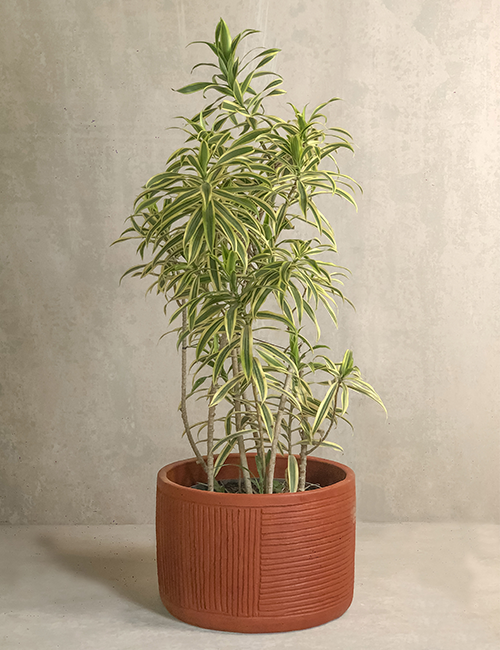 The Song of India variety of dracaena (Dracaena reflexa ‘Variegata’), also known as pleomele, is native to islands in the Indian Ocean near Madagascar. In the wild or in a garden with the right conditions, this dracaena will grow as tall as 5.5 meters, with a spread out to 2.5 meters Diameter pot 35cm Song of India needs bright, indirect light. Intense, direct sun will unfortunately burn the leaves and low light will cause the plant’s yellow-lime striped vibrancy to fade and the plant to turn spindly. Mild morning sun can be an option. 2-3 times a week, allow the top couple of inches to dry out before watering it thoroughly.
The Song of India variety of dracaena (Dracaena reflexa ‘Variegata’), also known as pleomele, is native to islands in the Indian Ocean near Madagascar. In the wild or in a garden with the right conditions, this dracaena will grow as tall as 5.5 meters, with a spread out to 2.5 meters Diameter pot 35cm Song of India needs bright, indirect light. Intense, direct sun will unfortunately burn the leaves and low light will cause the plant’s yellow-lime striped vibrancy to fade and the plant to turn spindly. Mild morning sun can be an option. 2-3 times a week, allow the top couple of inches to dry out before watering it thoroughly. -
 The elongated leaves of the Schefflera plant liken its shape to that of an umbrella. Thus its nickname, the Umbrella Tree, makes a lot of visual sense. The combination of its attractive leaves and detoxifying powers makes the Schefflera plant a very popular indoor plant. Our experts at Ambius know how popular the Schefflera plants are, and can help improve your business or office environment Schefflera plants prefer medium-light, meaning they should be kept in bright light, but the light should not be direct. The best advice is to water once the top soil becomes dry. Over-watering is more of a problem than lack of water.
The elongated leaves of the Schefflera plant liken its shape to that of an umbrella. Thus its nickname, the Umbrella Tree, makes a lot of visual sense. The combination of its attractive leaves and detoxifying powers makes the Schefflera plant a very popular indoor plant. Our experts at Ambius know how popular the Schefflera plants are, and can help improve your business or office environment Schefflera plants prefer medium-light, meaning they should be kept in bright light, but the light should not be direct. The best advice is to water once the top soil becomes dry. Over-watering is more of a problem than lack of water. -
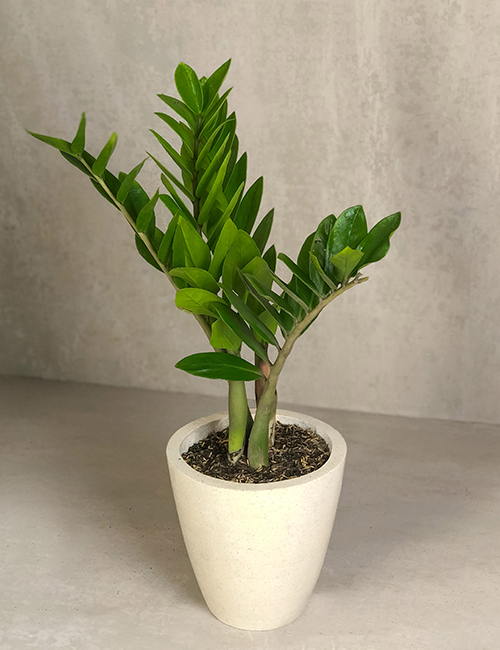 The ZZ (Zamioculcas zamiifolia), or Zanzibar Gem, is a semi-succulent native to the semi-arid regions of Eastern Africa. It is accustomed to long periods of dry conditions interspersed with bursts of generous rain Bright light is good but not essential. The zamioculcas zamiifolia grows fine with low levels of light, but it's best to avoid direct sunlight. Allow the soil to become dry at the top to the touch between watering and do not over water. It's best to water this plant less than too much because over-watering can cause stem and rhizome rot.
The ZZ (Zamioculcas zamiifolia), or Zanzibar Gem, is a semi-succulent native to the semi-arid regions of Eastern Africa. It is accustomed to long periods of dry conditions interspersed with bursts of generous rain Bright light is good but not essential. The zamioculcas zamiifolia grows fine with low levels of light, but it's best to avoid direct sunlight. Allow the soil to become dry at the top to the touch between watering and do not over water. It's best to water this plant less than too much because over-watering can cause stem and rhizome rot.
